Esri Model Builder Upload Publish to Online
As we go on the fight against COVID-19 and enter the wildfire and hurricane season, spider web applications like dashboards assist people make informed, time-sensitive, and even life-saving decisions. Depending on the events your organization is monitoring, things tin can modify apace. Y'all'll need to efficiently publish your web layers, update your information, and overwrite your web layers to continue your dashboards current and relevant.
ModelBuilder in ArcGIS Pro allows you to automate analyzing and updating the data used in your web layers. You may already take a model y'all routinely run to prepare your data for publishing. All that remains is the power to publish web layers or overwrite existing ones in the model. In this article, y'all'll acquire how to create a script tool in ArcGIS Pro 2.8 that publishes or overwrites a web feature layer. The script tool is built on ArcPy functions and geoprocessing tools, allowing you to run it like any other geoprocessing tool in new or existing ModelBuilder models.
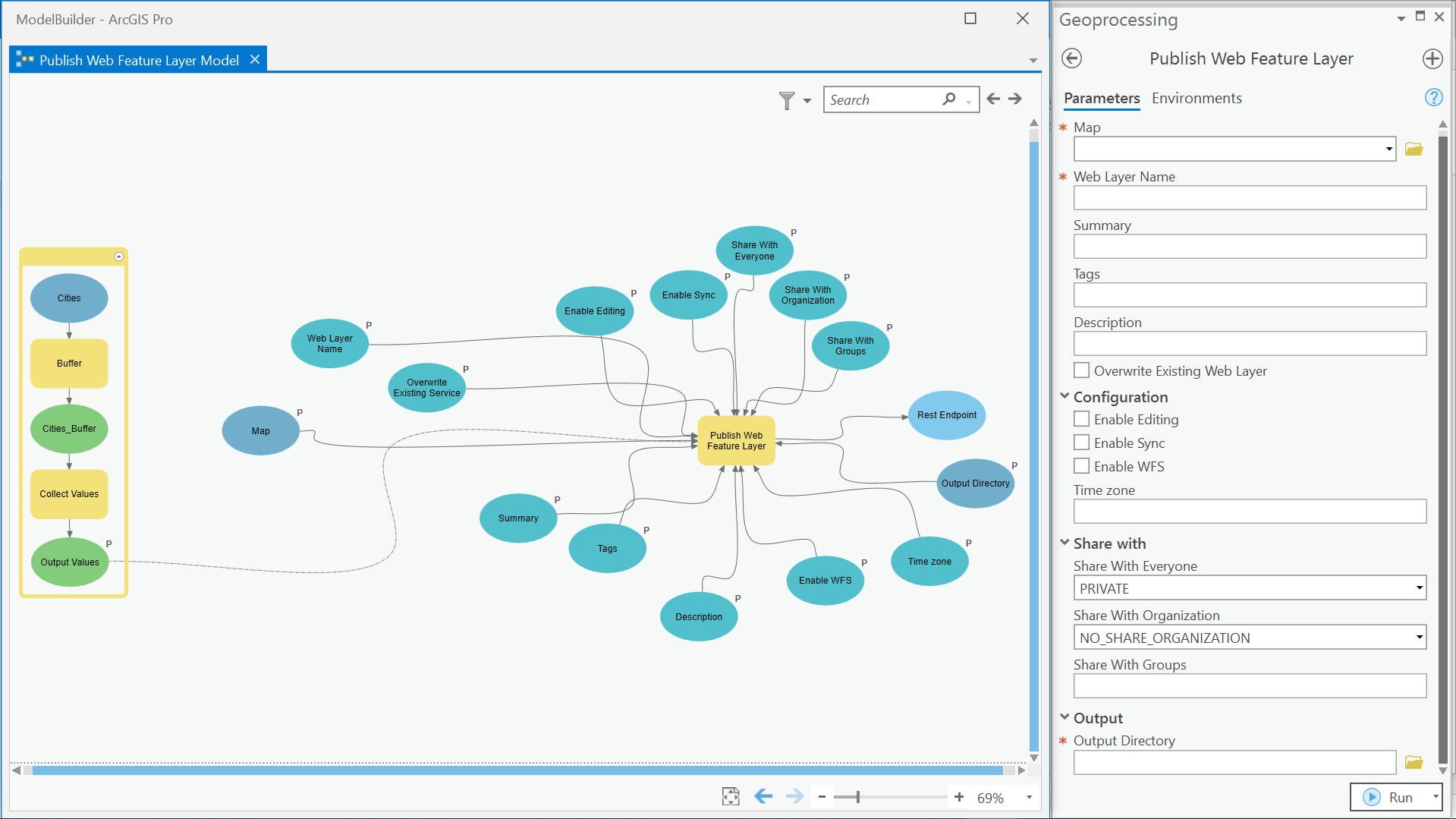
Y'all'll be guided through each of the four steps below:
- Write a Python script. (Not too familiar with Python? Don't worry; a sample script is provided that you tin can modify to run across your specific needs.)
- Create a script tool.
- Add the script tool to ModelBuilder.
- Run the model.
If you want to view the completed script tool and come across how it works in an existing model, download this project to follow along.
Step 1: Write a Python script
The code beneath publishes a new web feature layer or overwrites an existing spider web characteristic layer in ArcGIS Online or ArcGIS Enterprise. Copy and paste the script in a text editor like Notepad and relieve it every bit a Python file (.py). This script can be modified to meet your specific needs. Y'all'll learn how to do this under Adjacent Steps at the end of this article. If y'all would similar to larn more about this publishing script and others similar it, see Introduction to arcpy.sharing.
Stride two: Create a script tool
Side by side, follow all three sections beneath to create a script tool.
Create a custom toolbox to store your tool
1. Open your ArcGIS Pro project. In the Catalog pane, correct-click Toolboxes and click New Toolbox.
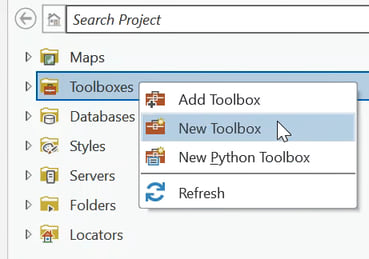
ii. On the New Toolbox dialog box, provide a name for your toolbox and click Salve.
Import the Python script
- In the Catalog pane, correct-click the new toolbox you just created, and select New > Script.
- On the New Script dialog box, under General, provide the following:
Proper noun: PublishWebFeatureLayer
Characterization: Publish Web Feature Layer
- Browse to the location of the Python script file you lot saved earlier. Select the file and click OK.
- Check Import script.
- Go out the Tool Properties dialog box open up for the next department.
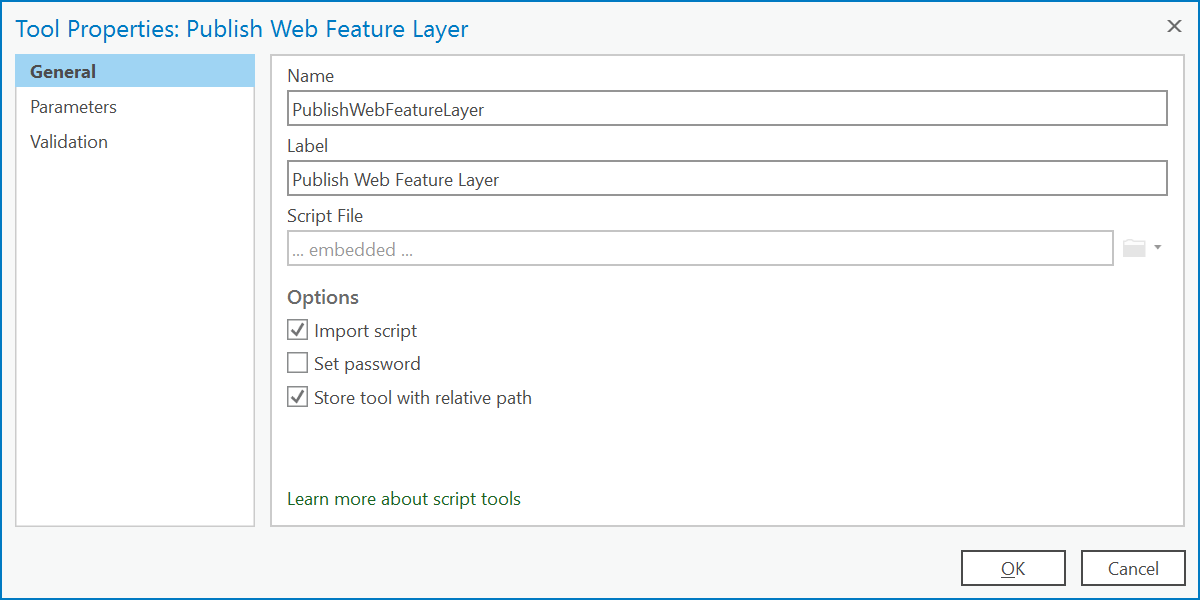
Define the parameters of your script tool
Parameters are variables that serve equally inputs for your script tool. When you run the tool, the Python script reads the parameter values before executing the residuum of the script.
Under Parameters, add the following parameters with their backdrop:
Annotation: These properties tin be modified based on your preferences. (For example, yous can change the Share With Organisation parameter then that it defaults to SHARE_ORGANIZATION instead of NO_SHARE_ORGANIZATION.)
0. Label: Map
Name: in_map
Information Type: Map
Blazon: Required
Direction: Input
1. Label: Web Layer Proper name
Name: service
Information Type: String
Type: Required
Management: Input
2. Characterization: Summary
Name: summary
Information Type: String
Type: Optional
Direction: Input
3. Label: Tags
Proper name: tags
Data Blazon: String
Type: Optional
Direction: Input
4. Characterization: Clarification
Name: description
Data Type: String
Blazon: Optional
Direction: Input
five. Label: Overwrite Existing Web Layer
Name: overwrite_existing_service
Data Type: Boolean
Blazon: Optional
Direction: Input
6. Characterization: Enable Editing
Name: enableEditing
Information Type: Boolean
Type: Optional
Direction: Input
Category: Configuration
7. Label: Enable Sync
Proper name: enableSync
Information Blazon: Boolean
Blazon: Optional
Direction: Input
Category: Configuration
viii. Label: Enable WFS
Proper name: enableWFS
Data Type: Boolean
Blazon: Optional
Direction: Input
Category: Configuration
9. Label: Time zone
Name: timezone
Information Type: String
Blazon: Optional
Direction: Input
Category: Configuration
ten. Label: Share With Everyone
Name: share_public
Information Type: String
Blazon: Optional
Direction: Input
Category: Share with
Filter: Value List
PUBLIC
PRIVATE
Default: Private
eleven. Label: Share With Arrangement
Name: share_organization
Data Blazon: String
Type: Optional
Direction: Input
Category: Share with
Filter: Value List
SHARE_ORGANIZATION
NO_SHARE_ORGANIZATION
Default: NO_SHARE_ORGANIZATION
12. Label: Share With Groups
Proper name: share_groups
Data Type: String
Type: Optional
Management: Input
Category: Share with
13. Label: Output Directory
Proper noun: sddraft_output_directory
Data Type: Binder
Blazon: Required
Direction: Input
Category: Output
fourteen. Characterization: Rest Endpoint
Name: Rest_Endpoint
Data Type: Cord
Blazon: Derived
Management: Output
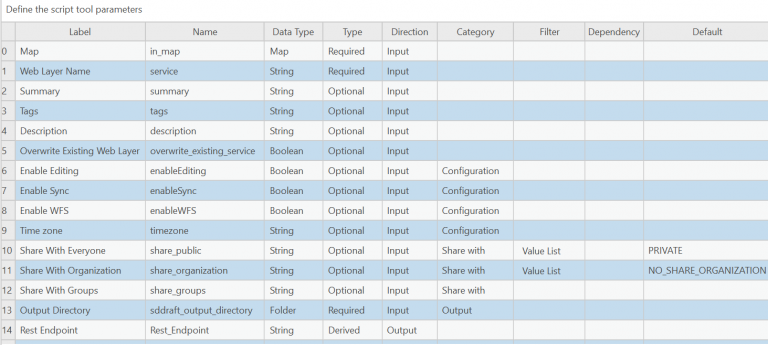
Now that you've imported your script and gear up parameters for your tool, click OK on the Tool Properties dialog box.
Learn more near setting script tool parameters
Permit'due south examine the script tool you created. Double-click your script tool to open it.
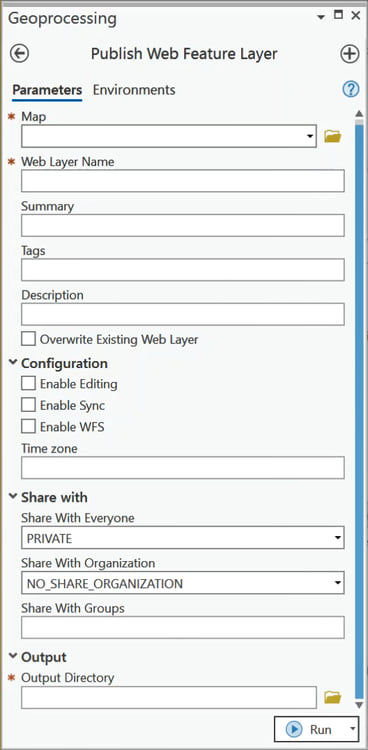
Publish Web Characteristic Layer is now a custom geoprocessing tool that tin can be run like whatsoever other arrangement geoprocessing tool. It's ready to be added to a model.
Optional: Include metadata
When creating a custom geoprocessing tool, it's recommended to include documentation that helps others use your tool.
Correct-click your script and click Edit Metadata.
Enter tags, summary, and usage. Under Syntax, fill out the fields beneath and click Save.
in_map:
Dialog Caption: Map to publish.
Scripting Caption: Map object of the map to publish.
service:
Dialog Explanation: Enter the name of a new or existing web layer. If the name already exists, the web layer volition be overwritten. Otherwise, a new web layer will be created.
Scripting Explanation: A string that represents the service name.
summary:
Dialog Explanation: Enter a brusque summary of the web layer.
Scripting Explanation: A cord that represents summary.
tags:
Dialog Explanation: Enter keywords or terms that describe the web layer.
Scripting Explanation: A string that represents tags, with different tags separated by comma.
description:
Dialog Caption: Enter an in-depth clarification of the item.
Scripting Explanation: A string that represents a description.
overwrite_existing_service:
Dialog Explanation: If checked and a spider web layer with the same name exists, information technology volition exist overwritten.
Scripting Explanation: A Boolean that determines whether to overwrite an existing web layer.
enableEditing:
Dialog Explanation: Allow users to edit the web layer.
Scripting Explanation: A Boolean that determines whether to enable editing.
enableSync:
Dialog Caption: Disconnected editing with synchronization.
Scripting Explanation: A Boolean that determines whether to enable sync.
enableWFS:
Dialog Explanation: Include a WFS layer.
Scripting Explanation: A Boolean that determines whether to share a WFS layer likewise.
timezone:
Dialog Explanation: Enter the time zone in which your appointment values are stored.
Scripting Caption: A string to set the time zone.
share_public:
Dialog Explanation: Share web layer with the public.
Scripting Explanation: A string that determines if the layer is PUBLIC or Individual.
share_organization:
Dialog Explanation: Share web layer with all authenticated users in your organization.
Scripting Caption: A string that determines whether the layer is shared to the organization.
share_groups:
Dialog Explanation: Share web layer with groups you belong to and its members.
Scripting Explanation: List of existing groups that the layer is to be shared to.
sddraft_output_directory:
Dialog Explanation: The binder on disk where your .sddraft and .sd files volition exist stored.
Scripting Caption: Output directory to create .sddraft and .sd files.
Step 3: Add the script tool to ModelBuilder
To use the tool in ModelBuilder, open an existing model or right-click the toolbox and select New > Model to create a new model. Correct-click the script in your toolbox and click Add together To Model (or drag it into your model).

Yous can include other geoprocessing tools in your model. For instance, y'all can set other processes as preconditions so that they execute before the web layer is overwritten. To learn more than, see Utilise ModelBuilder.
Step 4: Run the model
Double-click the tool and fill out the fields. To overwrite a web layer, provide the name of the existing web layer and cheque the Overwrite Existing Spider web Layer bank check box. If the name already exists, the web layer will be overwritten. Otherwise, a new web layer will be created. Before running it, validate the model to ensure that it will successfully run by clicking ModelBuilder > Run > Validate. One time the model has been validated, click Run to run the entire model. You lot tin can also schedule a model to run repeatedly or at a designated fourth dimension.

After the model successfully runs, add together the web layer to a map in ArcGIS Pro or open information technology in Map Viewer.
Next steps
In this article, you learned how to publish and overwrite web feature layers in ModelBuilder past creating and running a script tool in a model. One of the advantages of authoring your ain script tool is that yous can change it to meet your specific needs. A couple of examples are provided below. If you want to learn more about automating sharing workflows in ArcGIS Pro, run into Introduction to arcpy.sharing.
Allow'southward suppose you want to publish your spider web feature layer to a portal folder and let users to export the data. This tin exist washed by adding the portalFolder and allowExporting backdrop in the FeatureSharingDraft.
Right-click the script tool in your toolbox and click Edit. Change the Python file as shown below.
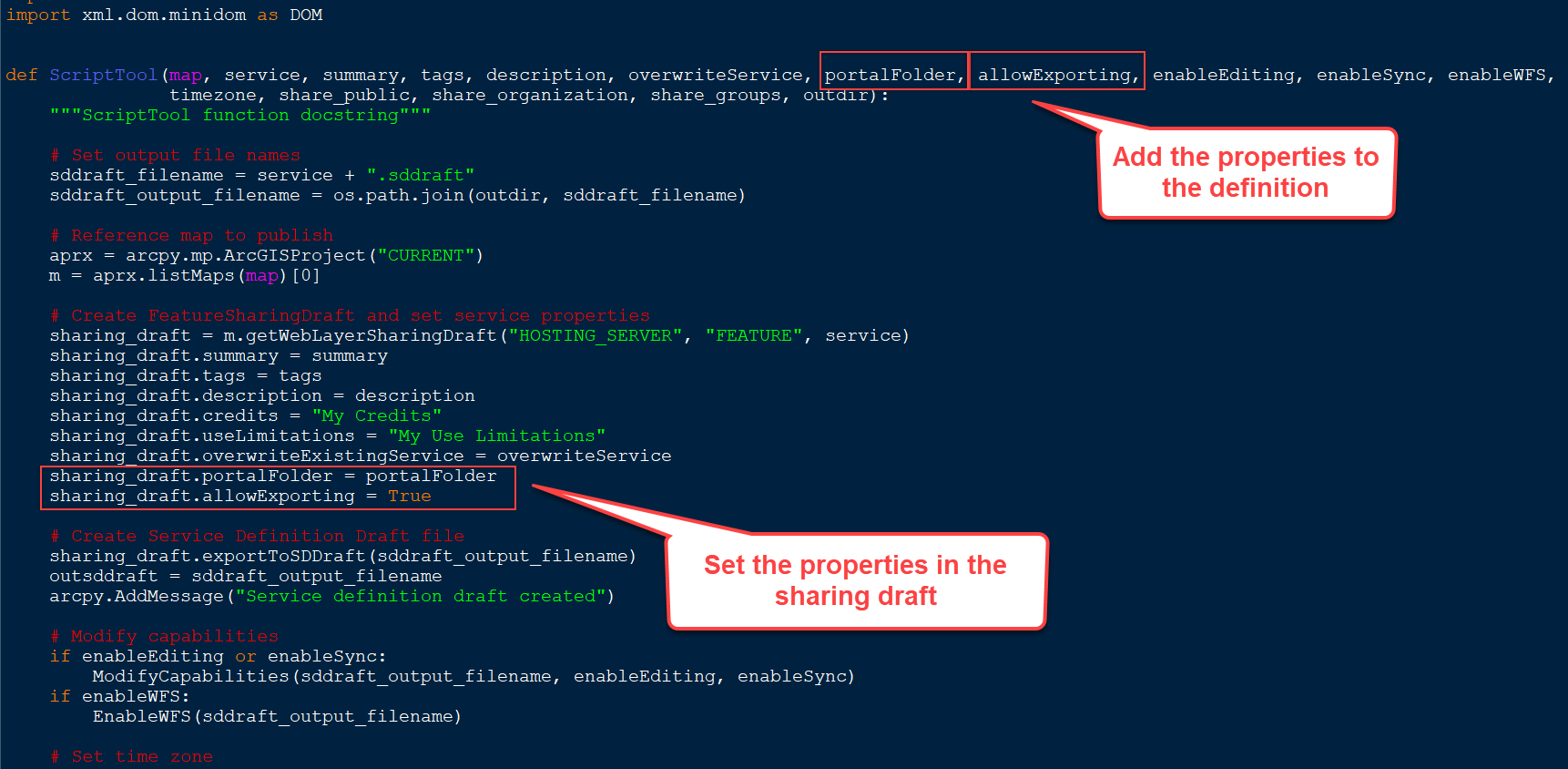
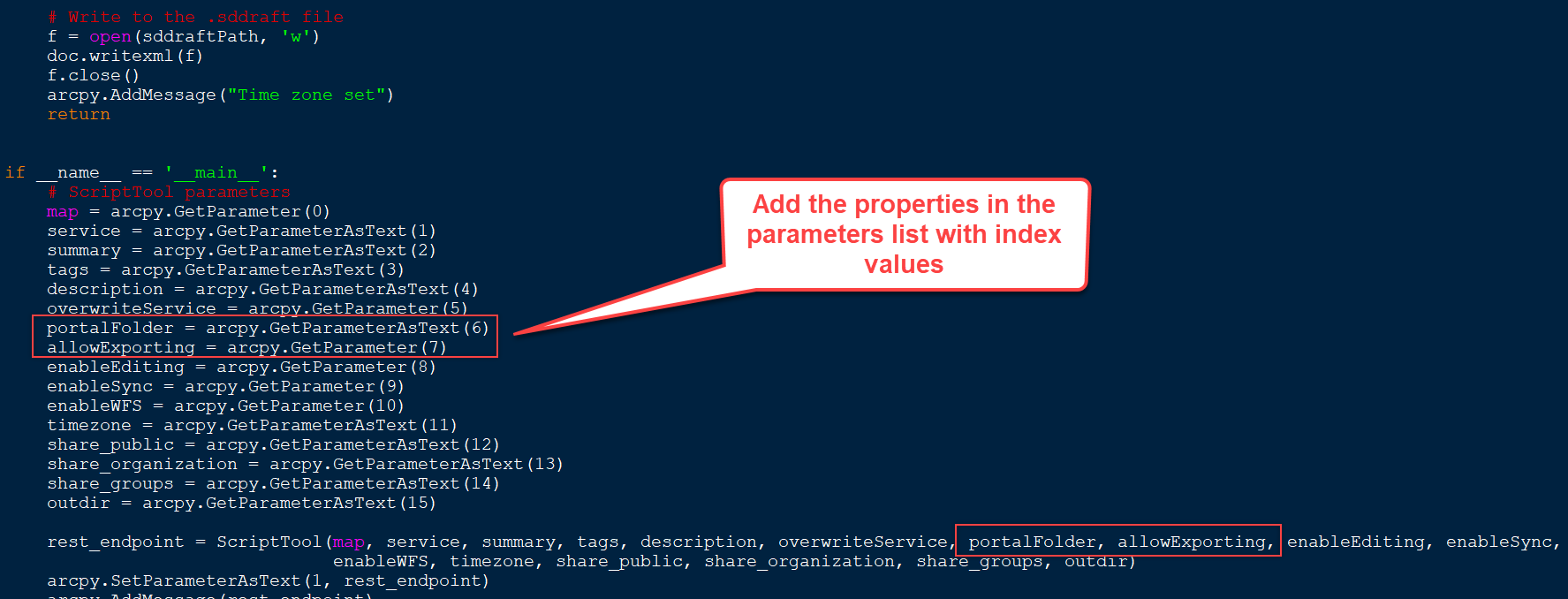
Salvage the file. Right-click the script tool and click Backdrop. Add two more than script tool parameters (6 and 11) for the new properties.
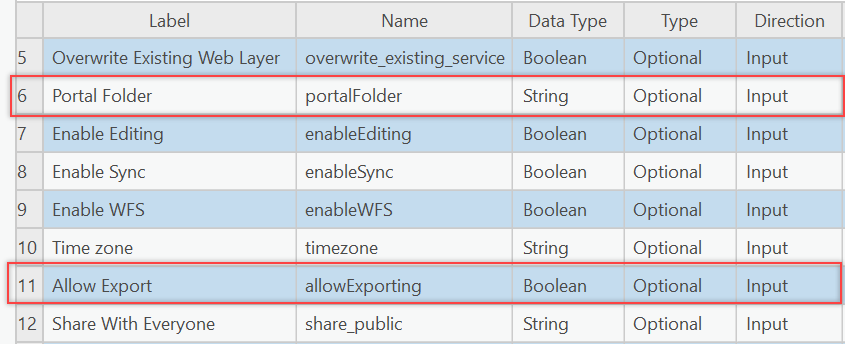
Using what you've learned in the previous sections, you can create a script tool specific to map image layers. The code below publishes or overwrites a map paradigm layer on ArcGIS Enterprise. Follow the same steps discussed previously: save the code as a new Python file (.py), create a script tool, import the .py file, and define script tool parameters. Add the script tool to ModelBuilder and run the model when you have configured it to run across your needs.
The need for readily bachelor information during times of crisis makes your GIS work invaluable. In this article, nosotros've discussed how to create and utilise script tools and ModelBuilder in ArcGIS Pro to efficiently publish and update your spider web layers. Learn more than about how to share your work in ArcGIS Pro.
menesesacurnhooks.blogspot.com
Source: https://www.esri.com/arcgis-blog/products/arcgis-pro/mapping/publish-and-overwrite-web-layers-in-modelbuilder/
0 Response to "Esri Model Builder Upload Publish to Online"
Post a Comment